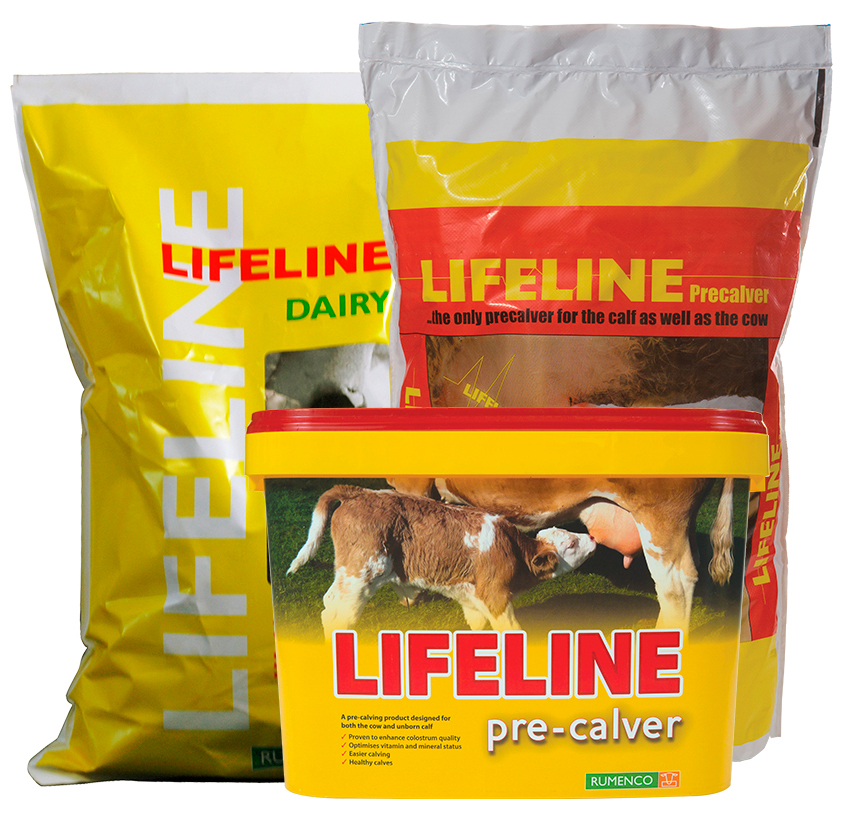Spring into Calving with LIFELINE

Figures suggest that for every calf lost at, or after calving, then breeding herds are missing out on a substantial £636 in calf output which has a significant negative effect on the overall bottom line of any business. With another spring calving just around the corner, Rumenco Technical Adviser Laura Drury discusses how simple, small changes to the cow’s diet in the run up to calving can have a significant financial impact by helping to minimise losses during this critical period.
Calving difficulty, although commonly avoidable, continues to be the main cause of calf losses in the cattle industry with data showing that losses within the first 24 hours are four times greater following an assisted calving compared to unassisted.
Labour and veterinary costs make up a substantial proportion of the cost of assisted calvings, yet these are only the tip of the iceberg. Cow and calf deaths, delayed rebreeding, failure to rebreed, reduced immunity in calves and general lack of thrift are all linked directly to difficult calvings which aside from the direct costs of lost calves can still be costing up to £300 per cow per incidence.
But how does a difficult calving increase calf mortality? Not only is the calf more susceptible to scours and respiratory disease, but it will also be at increased risk of hypothermia. Furthermore, antibody absorption from colostrum will also be reduced which is critical for the calf’s survival.
Feeding dry cows correctly, with a focus on achieving target body condition scores at calving, is one area producers can directly influence calving ease and subsequent colostrum production. Over-conditioned cows are at greater risk of a difficult calving, whereas cows in poor condition are more likely to produce calves with less vigour as well as poorer quality colostrum.
"Supplying balanced minerals and vitamins also directly influences both cow and calf outcomes at calving."
Magnesium is key for muscle tone and the generation of strong calving contractions supporting a quick and easy calving, which is especially important in first-calving heifers which typically present the highest potential problem in terms of calving difficulty.
Other minerals should not be over-looked as calving approaches in order to help ensure good herd health and performance. Selenium and vitamin E, through their role in immunity, have been shown to support newborn calf vigour whilst also aiding in the management of retained placentas and mastitis in the dam.
"the free flowing mineral crumb format is ideal for housed dry cows."
Available as a bucket, mineral crumb or high specification dairy mineral, Rumenco’s specialist LIFELINE Pre-Calver helps ensure all of these aspects are covered – specifically formulated to include an optimal supply of these key minerals and vitamins, plus other nutritional additives, it is targeted for feeding during the final 6 weeks before calving to aid in an easier calving the production of vigorous calves.
Whilst offering all of these key benefits, the free-flowing mineral crumb format is ideal for housed dry cows, suitable for top-dressing onto forages or for addition to mixer wagons, whilst also having the extra benefit of allowing producers to regulate and have more control over target intakes.
In addition, the LIFELINE Pre-Calver bucket has been proven to increase the IgG content (quality) of colostrum by 9.5% when compared to a standard magnesium bucket, costing just an additional £3.59** per cow over the recommended 6 week feeding period. Given the unique benefits of the product and the resulting potential increased calf output, this more than pays for the additional cost.
Ensuring cows and heifers are fed according to their needs will directly influence this year’s spring calving success, and adding LIFELINE Pre-Calver, either as a bucket, mineral crumb or dairy mineral, to your herd’s feeding plan from 6 weeks pre-calving, will help support your herd through this crucial part of the year. After all, you only get one chance to secure the future.
*Liver copper concentrations in cull cattle in the UK: are cattle being copper loaded? 2015. Veterinary Record, 177 (19), pp. 493/1-493/4.
**Based on Rumenco RRP
For further information about these products please contact us via our contact us page or for your local stockist visit our local stockist page.